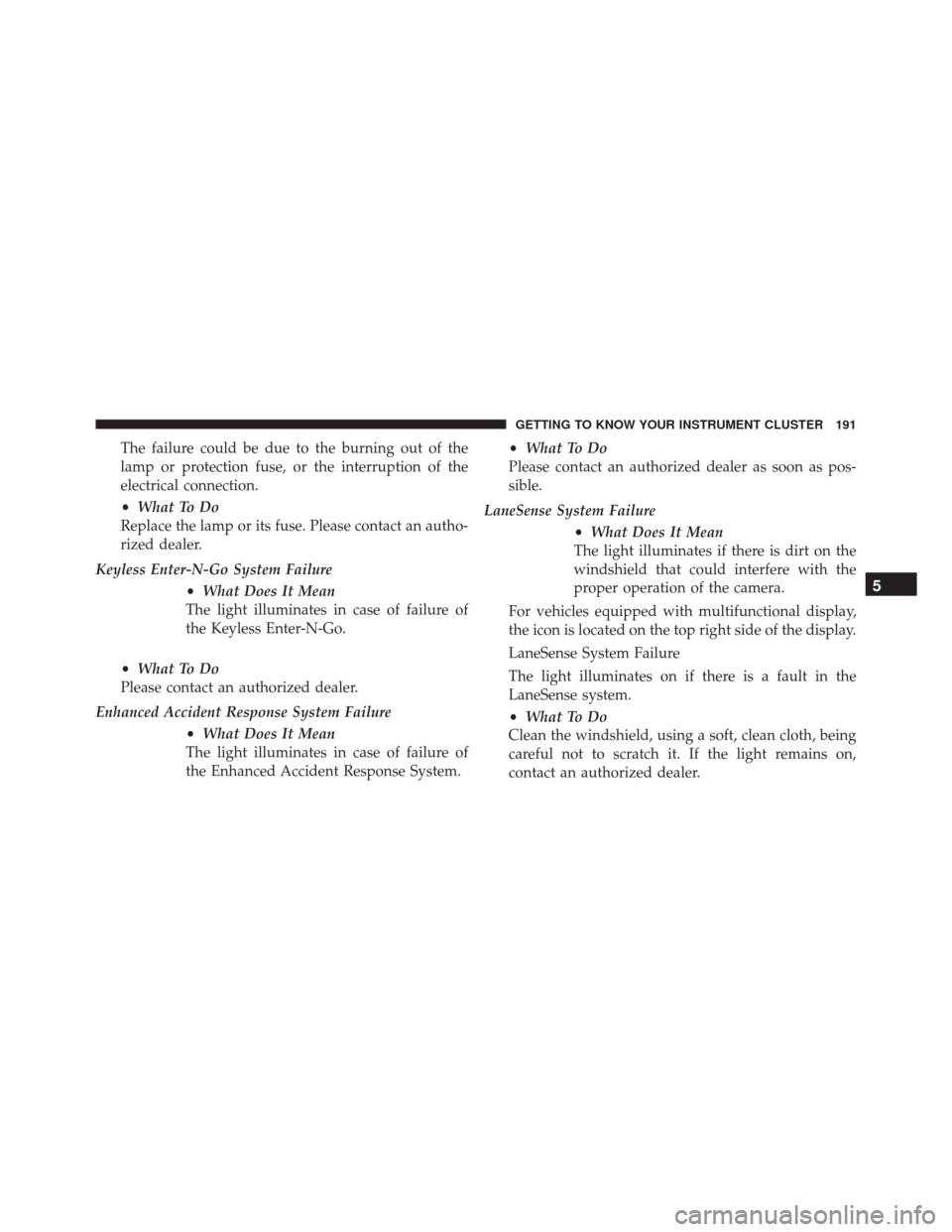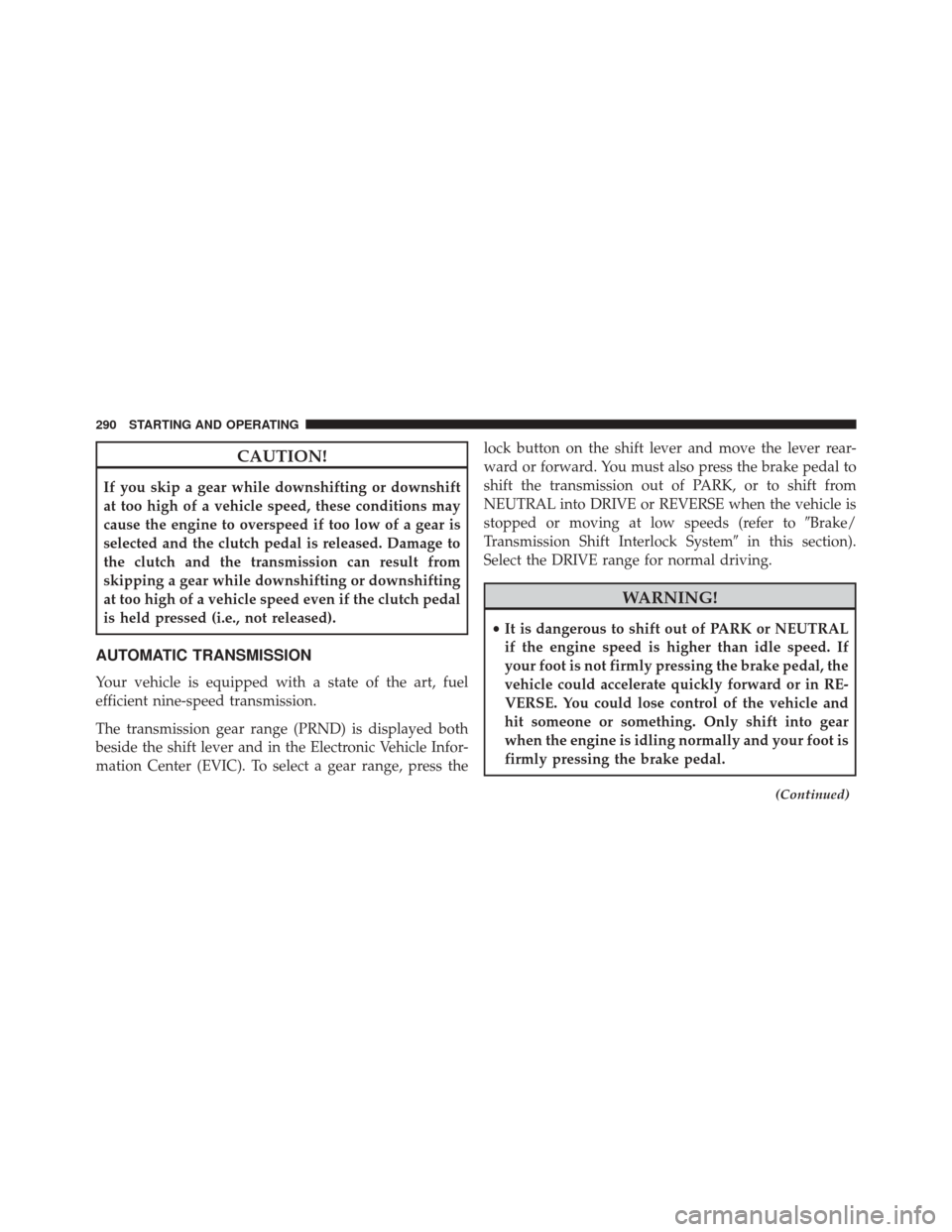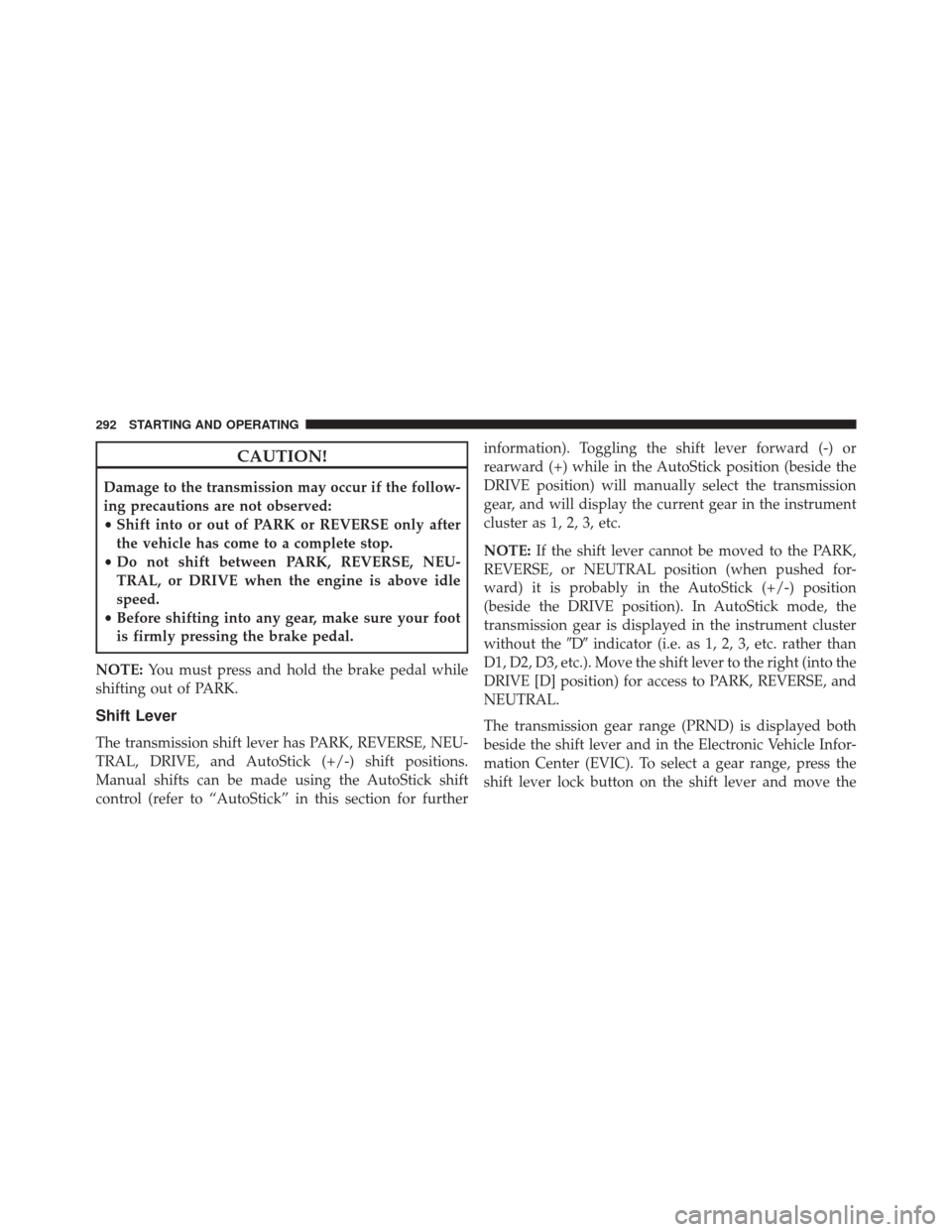Page 188 of 587

Symbols Displayed In The EVIC
Oil Pressure Warning Light•What Does It Mean
This telltale indicates low engine oil pressure.
If the light turns on while driving, stop the vehicle
and shut off the engine as soon as possible. A chime
will sound when this light turns on.
Do not operate the vehicle until the cause is cor-
rected. This light does not show how much oil is in
the engine. The engine oil level must be checked
under the hood.
NOTE: If the symbol comes on while driving, stop the
engine immediately and see an authorized dealer as soon
as possible. Air Bag Warning Light
•What Does It Mean
Illumination of the Air Bag Warning Light
indicates a failure of the air bag system
when the ignition switch is placed in the
MAR/RUN position.
The display shows the message dedicated.
• What To Do
If the light is either not on during starting, stays on,
or turns on while driving, have the system inspected
at an authorized dealer as soon as possible.
Charging System Light •What Does It Mean
This light shows the status of the electrical
charging system. If the light stays on or comes on
while driving, turn off some of the vehicle’s non-
essential electrical devices or increase engine speed
186 GETTING TO KNOW YOUR INSTRUMENT CLUSTER
Page 193 of 587

The failure could be due to the burning out of the
lamp or protection fuse, or the interruption of the
electrical connection.
•What To Do
Replace the lamp or its fuse. Please contact an autho-
rized dealer.
Keyless Enter-N-Go System Failure •What Does It Mean
The light illuminates in case of failure of
the Keyless Enter-N-Go.
• What To Do
Please contact an authorized dealer.
Enhanced Accident Response System Failure •What Does It Mean
The light illuminates in case of failure of
the Enhanced Accident Response System. •
What To Do
Please contact an authorized dealer as soon as pos-
sible.
LaneSense System Failure •What Does It Mean
The light illuminates if there is dirt on the
windshield that could interfere with the
proper operation of the camera.
For vehicles equipped with multifunctional display,
the icon is located on the top right side of the display.
LaneSense System Failure
The light illuminates on if there is a fault in the
LaneSense system.
• What To Do
Clean the windshield, using a soft, clean cloth, being
careful not to scratch it. If the light remains on,
contact an authorized dealer.
5
GETTING TO KNOW YOUR INSTRUMENT CLUSTER 191
Page 238 of 587

Enhanced Accident Response System Reset
Procedure
After the event occurs, when the system is active, a
message regarding fuel cutoff is displayed. Turn the
ignition switch from ignition AVV/START or MAR/
ACC/ON/RUN to ignition STOP/OFF/LOCK. Care-
fully check the vehicle for fuel leaks in the engine
compartment and on the ground near the engine com-
partment and fuel tank before resetting the system and
starting the engine.
Depending on the nature of the event the left and right
turn signal lights, located in the instrument panel, may
both be blinking and will continue to blink. In order to
move your vehicle to the side of the road, you must
follow the system reset procedure.
Customer Action Customer Will See
1. Turn Ignition OFF.
(Turn Signal Switch Must Be Placed In Neutral State).
2. Turn Ignition ON. Left Turn Light Is OFF. Right Turn LightBLINKS.
3. Turn Right Turn Signal Switch ON. Right Turn Light Is ON
SOLID. Left Turn Light BLINKS.
4. Turn Left Turn Signal Switch ON. Left Turn Light Is ON
SOLID. Right Turn Signal Light BLINKS.
5. Turn Right Turn Signal Switch ON. Right Turn Light Is ON
SOLID. Left Turn Light BLINKS.
236 SAFETY
Page 278 of 587

Turbo engine below -20°F (-29°C) and for the 2.4L engine
below -29°F (-34°C) and is recommended for the 2.4L
engine below -20°F (-29°C).
To prevent possible engine damage while starting at low
temperatures, this vehicle will inhibit engine cranking
when the ambient temperature is less than -34°F (-35°C)
and the oil temperature sensor reading indicates an
engine block heater has not been used. The message
“plug in engine heater” will be displayed in the instru-
ment cluster when the ambient temperature is below -4°F
(-20°C) at the time the engine is shut off as a reminder to
avoid possible crank delays at the next cold start.
Extended Park Starting
NOTE:Extended Park condition occurs when the vehicle
has not been started or driven for at least 35 days.
1. Install a battery charger or jumper cables to the battery to ensure a full battery charge during the crank cycle. 2. Cycle the ignition in the START position and release it
when the engine starts.
3. If the engine fails to start within ten seconds, cycle the ignition to the STOP (OFF/LOCK) position, wait five
seconds to allow the starter to cool, then repeat the
Extended Park Starting procedure.
4. If the engine fails to start after eight attempts, allow the starter to cool for at least 10 minutes, then repeat
the procedure.
CAUTION!
To prevent damage to the starter, do not crank con-
tinuously for more than 10 seconds at a time. Wait 10
to 15 seconds before trying again.
276 STARTING AND OPERATING
Page 289 of 587
To shift the gears, press the clutch pedal to the floor and
put the shift lever to the desired position (the diagram for
the engagement of the gears is displayed on the handle of
the lever).To engage REVERSE gear from the NEUTRAL position
lift the REVERSE ring, located below the knob and
simultaneously move the lever to the left and then
forward.
Shifting
Fully press the clutch pedal before shifting gears. As you
release the clutch pedal, lightly press the accelerator
pedal.
You should always use first gear when starting from a
standing position.
Recommended Vehicle Shift Speeds
To utilize your manual transmission efficiently for fuel
economy and performance, it should be upshifted as
listed in the recommended shift speed chart. Shift at the
vehicle speeds listed for acceleration. When heavily
loaded or pulling a trailer, these recommended up-shift
speeds may not apply.
REVERSE Ring
7
STARTING AND OPERATING 287
Page 292 of 587

CAUTION!
If you skip a gear while downshifting or downshift
at too high of a vehicle speed, these conditions may
cause the engine to overspeed if too low of a gear is
selected and the clutch pedal is released. Damage to
the clutch and the transmission can result from
skipping a gear while downshifting or downshifting
at too high of a vehicle speed even if the clutch pedal
is held pressed (i.e., not released).
AUTOMATIC TRANSMISSION
Your vehicle is equipped with a state of the art, fuel
efficient nine-speed transmission.
The transmission gear range (PRND) is displayed both
beside the shift lever and in the Electronic Vehicle Infor-
mation Center (EVIC). To select a gear range, press thelock button on the shift lever and move the lever rear-
ward or forward. You must also press the brake pedal to
shift the transmission out of PARK, or to shift from
NEUTRAL into DRIVE or REVERSE when the vehicle is
stopped or moving at low speeds (refer to
�Brake/
Transmission Shift Interlock System �in this section).
Select the DRIVE range for normal driving.
WARNING!
• It is dangerous to shift out of PARK or NEUTRAL
if the engine speed is higher than idle speed. If
your foot is not firmly pressing the brake pedal, the
vehicle could accelerate quickly forward or in RE-
VERSE. You could lose control of the vehicle and
hit someone or something. Only shift into gear
when the engine is idling normally and your foot is
firmly pressing the brake pedal.
(Continued)
290 STARTING AND OPERATING
Page 294 of 587

CAUTION!
Damage to the transmission may occur if the follow-
ing precautions are not observed:
•Shift into or out of PARK or REVERSE only after
the vehicle has come to a complete stop.
• Do not shift between PARK, REVERSE, NEU-
TRAL, or DRIVE when the engine is above idle
speed.
• Before shifting into any gear, make sure your foot
is firmly pressing the brake pedal.
NOTE: You must press and hold the brake pedal while
shifting out of PARK.
Shift Lever
The transmission shift lever has PARK, REVERSE, NEU-
TRAL, DRIVE, and AutoStick (+/-) shift positions.
Manual shifts can be made using the AutoStick shift
control (refer to “AutoStick” in this section for further information). Toggling the shift lever forward (-) or
rearward (+) while in the AutoStick position (beside the
DRIVE position) will manually select the transmission
gear, and will display the current gear in the instrument
cluster as 1, 2, 3, etc.
NOTE:
If the shift lever cannot be moved to the PARK,
REVERSE, or NEUTRAL position (when pushed for-
ward) it is probably in the AutoStick (+/-) position
(beside the DRIVE position). In AutoStick mode, the
transmission gear is displayed in the instrument cluster
without the �D�indicator (i.e. as 1, 2, 3, etc. rather than
D1, D2, D3, etc.). Move the shift lever to the right (into the
DRIVE [D] position) for access to PARK, REVERSE, and
NEUTRAL.
The transmission gear range (PRND) is displayed both
beside the shift lever and in the Electronic Vehicle Infor-
mation Center (EVIC). To select a gear range, press the
shift lever lock button on the shift lever and move the
292 STARTING AND OPERATING
Page 298 of 587

CAUTION!
•Before moving the shift lever out of PARK, you
must turn the ignition switch from the STOP/OFF
position to the MAR/RUN position, and also press
the brake pedal. Otherwise, damage to the shift
lever could result.
• DO NOT race the engine when shifting from
PARK or NEUTRAL into another gear range, as this
can damage the drivetrain.
The following indicators should be used to ensure that
you have engaged the transmission into the PARK posi-
tion:
• When shifting into PARK, press the LOCK button on
the shift lever and firmly move the shift lever all the
way forward until it stops and is fully seated.
• Look at the transmission gear position display and
verify that it indicates the PARK (P). •
With the brake pedal released, verify that the shift
lever will not move out of PARK.
Reverse (R)
This range is for moving the vehicle backward. Shift into
REVERSE only after the vehicle has come to a complete
stop.
Neutral (N)
Use this range when the vehicle is standing for prolonged
periods with the engine running. The engine may be
started in this range. Apply the EPB and shift the
transmission into PARK if you must leave the vehicle.
WARNING!
Do not coast in NEUTRAL and never turn off the
ignition to coast down a hill. These are unsafe
practices that limit your response to changing traffic
(Continued)
296 STARTING AND OPERATING